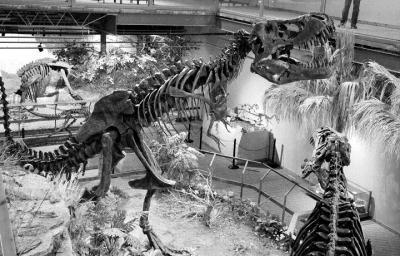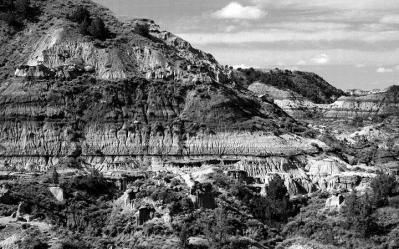 FIGURE 1. At first glance, the Glendive Dinosaur and Fossil Museum in Glendive, Montana, looks like a typical natural history museum.
FIGURE 1. At first glance, the Glendive Dinosaur and Fossil Museum in Glendive, Montana, looks like a typical natural history museum.
From the outside, the Glendive Dinosaur & Fossil Museum looks like any number of other dinosaur-related attractions in Montana. Its 20 000 square feet of displays features the head and jaws of a menacing Tyrannosaurus rex protruding through the museum’s front wall, and lifesized castings of dinosaur skeletons give the inside the look of a typical natural history museum (Figure 1). The museum opened in 2009 and in its first months of operation, it attracted more than 1000 visitors per month. Most of the $1.5 million needed to open the museum was raised by the Foundation Advancing Creation Truth from citizens and groups in Montana.
In a state filled with dinosaurrelated museums, the Glendive Dinosaur & Fossil Museum is the second-largest dinosaur museum in the state (only the famed Museum of the Rockies in Bozeman is larger). However, the Glendive Dinosaur & Fossil Museum is not your typical natural history museum. Instead, it’s an elaborate young-earth advertisement that uses Montana’s rich dinosaur-related history to lure people to lessons in biblical literalism and anti-science nonsense. As Jack Horner, the curator of paleontology at the Museum of the Rockies, has noted, “there’s nothing scientific about it.” Instead, the Glendive Dinosaur & Fossil Museum is “dedicated to the glory of God the Creator” as it combats “evolutionism’s nonsense” and the “abyss of scientific deception”. Otis Kline Jr, the museum’s founder and director, wanted to include his museum in the Montana Dinosaur Trail (see below), but he abandoned the group when it adopted the slogan “150 Million Years in the Making”.
Entering the museum, visitors walk over models of the sea floor, which claim that life “couldn’t have evolved or developed by chance”. Soon thereafter, there appear a 40-foot–long mosasaur, a 16-foot–long sea turtle, and a series of questions that challenge wellestablished discoveries; for example, did dinosaurs “coexist with man and diminish within the last 5000 years?”
The answers to these and other questions are on the museum’s second — and most entertainingly depressing — floor, which rings the main exhibits like a gallery (Figure 1). Atop the stairs is the usual “here’s why evolution is a lie” propaganda, including exhibits about “The failure of radiometric dating”, Ernst Haeckel, peppered moths, the Glen Rose dinosaur tracks, “irreducible complexity”, and a curious model of DNA and a cell. There’s also an exhibit of Australopithecus (“Lucy is not our ancestor”).
Each exhibit claims to prove evolution is a conspiracy perpetuated by scientists, and in the adjacent theater, you can watch movies such as “Incredible Creatures that Defy Evolution” and “The Faith Behind the Science.” Although several museums along the Montana Dinosaur Trail (see below) displayed Bibles, only in the Glendive Dinosaur & Fossil Museum were all of the Bibles open to the same passage: Book of Job 40 (which describes “Behemoth”) and 41 (which describes “Leviathan”). And, of course, you can help support the museum’s anti-science mission by spending some money in the gift shop.
The museum’s second floor tells visitors about the biblical flood and stresses how the Colorado River could not have carved the Grand Canyon (“it would have to flow uphill for over 2000 [feet]”). So what did form the Grand Canyon? “A global flood is the simplest explanation.” There’s “scientific” documentation of the remains of Noah’s Ark being found on the mountains of Ararat, as well as a large exhibit titled “Noah’s Ark — Eyewitness Accounts”. I learned that “Noah probably had approximately 16 000 animals on the Ark,” and a scale model of the ark shows tiny animals — dinosaurs included — walking onto the Ark two-by-two. How could Noah and the Ark’s seven other sailors have handled all of these animals? No problem: the animals “hibernated” to minimize the daily chores of the crew. How convenient.
The Glendive Dinosaur & Fossil Museum is located on the northeast corner of I-94 Exit 215 in Glendive, Montana, which is also home to Makoshika State Park, an area in the famous Hell Creek Formation that has yielded numerous discoveries of dinosaurs. Nearby, in downtown Glendive, is Makoshika Dinosaur Museum, which opened in 2004 and attracts 2000 visitors per summer.
 FIGURE 2. The badlands outside of Glendive, Montana, have yielded important discoveries of dinosaurs,and include dramatic exhibits of the Cretaceous–Tertiary boundary.
FIGURE 2. The badlands outside of Glendive, Montana, have yielded important discoveries of dinosaurs,and include dramatic exhibits of the Cretaceous–Tertiary boundary.
THE MONTANA DINOSAUR TRAIL
If you’re in Glendive and want to see some real science, get on the Montana Dinosaur Trail, a nonprofit set of museums created in 2005 to promote tourism at Montana’s dinosaur-related museums. To see all fifteen of the Trail’s museums, I drove 1348 miles and saw some fantastic exhibits and beautiful countryside. The centerpiece of the Trail is Bozeman’s Museum of the Rockies, which is just south of Montana State University. This museum, with one of the largest collections of dinosaurs in North America, is described by Frommer’s Montana and Wyoming as “one of the premier paleontology attractions in the world.” This is not an overstatement, for the museum houses numerous world-class exhibits, including those of the first identified female dinosaurs (an ovulating T rex), the world’s largest T rex skull, and some of the world’s rarest fossils.
Some other museums along the Trail aren’t nearly as famous or elaborate. Although some of these sites have only a few dinosaurrelated exhibits, many are rich in history. For example, the badlands near Garfield County Museum in Jordan, Montana (population 364) are where famed fossil-hunter Barnum Brown in 1902 excavated the first documented T rex. These badlands also show some of the most informative exposures of the K-T Boundary found anywhere in the world (Figure 2). The Carter County Museum in Ekalaka, Montana (population 410), was the first museum in Montana to display dinosaurs, and the 27 residents of Bynum, Montana (“25 in the offseason”), are justifiably proud of their Two Medicine Dinosaur Center, which houses the world’s longest dinosaur (the 137-foot–long Seismosaurus). Readers can find more information at The Montana Dinosaur Trail.
